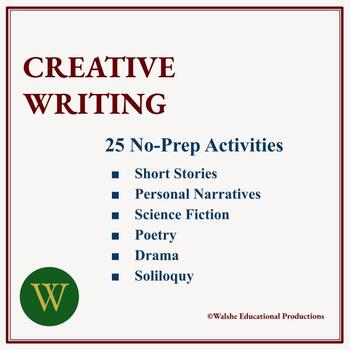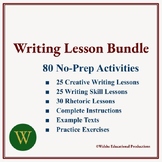Twenty-five Creative Writing Lessons
Walshe Educational Products
7 Followers
Grade Levels
8th - 12th, Higher Education, Adult Education, Homeschool
Subjects
Resource Type
Standards
CCSSW.11-12.2d
CCSSW.11-12.3
CCSSW.11-12.3a
CCSSW.11-12.3b
CCSSW.11-12.3c
Formats Included
- PDF
- Easel Activity
Pages
175 pages
Walshe Educational Products
7 Followers
Easel Activity Included
This resource includes a ready-to-use interactive activity students can complete on any device. Easel by TPT is free to use! Learn more.
Also included in
- Help your students build their writing skills and creativity and make your life much easier with this bundle of eighty no-prep lessons in Creative Writing, Rhetoric and Targeted Writing Practice. Each lesson comes with simple instructions, original mentor texts and skill building-activities for studPrice $72.00Original Price $80.00Save $8.00
Description
This product includes twenty-five no-prep Creative Writing lessons all with detailed instructions, optional rubrics and original mentor texts. Topics include: personal narrative, narrative voice, poetry, science fiction, interviews, drama, and more.
These lessons, like all my lessons, are made to be accessible to students by giving them the opportunity to practice their skills in the context of their own abilities and needs. This set of twenty-five lessons is available separately or as part of a discounted bundle that also includes 25 Writing Practice Lessons and Thirty Rhetoric lessons.
Total Pages
175 pages
Answer Key
Rubric only
Teaching Duration
1 Year
Report this resource to TPT
Reported resources will be reviewed by our team. Report this resource to let us know if this resource violates TPT’s content guidelines.
Standards
to see state-specific standards (only available in the US).
CCSSW.11-12.2d
Use precise language, domain-specific vocabulary, and techniques such as metaphor, simile, and analogy to manage the complexity of the topic.
CCSSW.11-12.3
Write narratives to develop real or imagined experiences or events using effective technique, well-chosen details, and well-structured event sequences.
CCSSW.11-12.3a
Engage and orient the reader by setting out a problem, situation, or observation and its significance, establishing one or multiple point(s) of view, and introducing a narrator and/or characters; create a smooth progression of experiences or events.
CCSSW.11-12.3b
Use narrative techniques, such as dialogue, pacing, description, reflection, and multiple plot lines, to develop experiences, events, and/or characters.
CCSSW.11-12.3c
Use a variety of techniques to sequence events so that they build on one another to create a coherent whole and build toward a particular tone and outcome (e.g., a sense of mystery, suspense, growth, or resolution).




